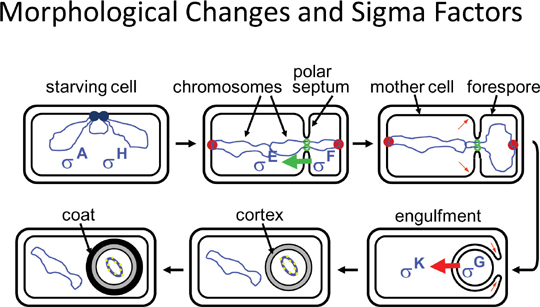Research: Project 1

In a starving cell, the DNA replication machinery (purple) completes chromosome (blue)
duplication. σA and σH RNA polymerase transcribe genes whose products cause the polar septum to form. A
region near each chromosome’s origin of replication is bound by a complex of proteins
(red) that attaches to the membrane at opposite cell poles. The polar septum forms
with the DNA translocase SpoIIIE (green) at the annulus, capturing one-third of one
chromosome in the forespore. σF becomes active in the forespore and this leads to activation of σE in the mother cell (green arrow). SpoIIIE translocates the remaining two-thirds of
one chromosome into the forespore. Products of genes under σF and σE control drive migration of the septal membranes around the forespore in the phagocytic-like
process of engulfment (orange arrows). Completion of engulfment pinches off the forespore
as a free protoplast within the mother cell. Two membranes surround the forespore
and separate its contents from the mother cell cytoplasm. σG becomes active in the forespore, leading to activation of σK in the mother cell (red arrow). Primarily, genes under σE and σK control cause synthesis of a loosely crosslinked peptidoglycan termed cortex, between
the two membranes surrounding the forespore, and synthesis of proteins that assemble
on the surface of the forespore to produce the spore coat. The forespore chromosome
is condensed into a toroid by binding of small, acid-soluble spore proteins (SASP)
(yellow), expressed under σG control. Not shown are subsequent steps which include spore maturation and release
of the spore via lysis of the mother cell.